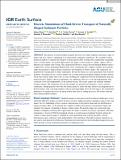Discrete Simulations of Fluid‐Driven Transport of Naturally Shaped Sediment Particles
Author(s)
Zhang, Qiong; Deal, Eric; Perron, J Taylor; Venditti, Jeremy G; Benavides, Santiago J; Rushlow, Matthew; Kamrin, Ken; ... Show more Show less
DownloadPublished version (1.374Mb)
Publisher with Creative Commons License
Publisher with Creative Commons License
Creative Commons Attribution
Terms of use
Metadata
Show full item recordAbstract
The particles in natural bedload transport processes are usually aspherical and span a range ofshapes and sizes, which is challenging to be represented in numerical simulations. We assemble existingnumerical methods to simulate the transport of natural gravel (NG). Starting with computerized tomographicscans of natural grains, our method approximates the shapes of these grains by “gluing” spheres (SP) ofdifferent sizes together with overlaps. The conglomerated SP move using a Discrete Element Method which iscoupled with a Lattice Boltzmann Method fluid solver, forming the first complete workflow from particleshape measurement to high‐resolution simulations with hundreds of distinct shapes. The simulations arequantitatively benchmarked by flume experiments. Beyond the flume, in a more generalized wide wall‐freegeometry, the numerical tool is used to further test a recently proposed modified sediment transport relation,which takes particle shape effects into account, including the competition between hydrodynamic drag andmaterial friction. Unlike a physical experiment, our simulations allow us to vary the hydrodynamic dragcoefficient of the NG independently of the material friction. The results support the modified sedimenttransport relation. The simulations also provide insights into particle‐level kinematics, such as particleorientations. Though particles below the bed surface prefer to orient with their shortest axes perpendicular tothe bed surface, with a decaying tendency with an increasing height above the bed surface, the orientationalpreferences in transport processes are much weaker than those in settling processes. NG rotates relativelyfreely during bedload transport.
Date issued
2025-04-29Department
Massachusetts Institute of Technology. Department of Mechanical Engineering; Massachusetts Institute of Technology. Department of Earth, Atmospheric, and Planetary SciencesJournal
Journal of Geophysical Research: Earth Surface
Publisher
Wiley
Citation
Zhang, Q., Deal, E., Perron, J. T., Venditti, J. G., Benavides, S. J., Rushlow, M., & Kamrin, K. (2025). Discrete simulations of fluid-driven transport of naturally shaped sediment particles. Journal of Geophysical Research: Earth Surface, 130, e2024JF007937.
Version: Final published version